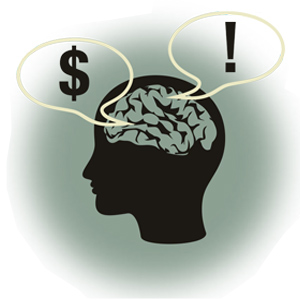Mind over Money

Emotion often drives our financial decisions, even when logic should.
When we go to the grocery store, we seldom shop on logic alone. We may not even buy on price. We buy one type of yogurt over another because of brand loyalty, or because one brand has more appealing packaging than another. We buy five bananas because they are on sale for 29 cents this week— “the bargain is right there; why not seize the opportunity?” We pick up that gourmet ice cream that everyone gets—“if everyone buys it, it must be a winner.”
As casual and arbitrary as these decisions may be, they are remarkably like the decisions many investors make in the financial markets.
A degree of emotion also factors into many of our financial choices. There is even a discipline devoted to how our emotions affect our financial decisions: behavioral finance. Examples of emotionally driven financial behaviors are all around us, especially in the investment markets.
Behavior #1: Believing future performance relates to past performance. In truth, there is no relationship. If an investment yields 8-10% for six consecutive years, that does not mean it will yield 8-10% next year. Still, we may be lulled into expecting such performance—how can you go wrong with such a “rock solid” investment? In behavioral finance, this is called recency bias. Bullish investors tend to harbor it, and it may lead to irrational exuberance.1
Similarly, investors adjust risk tolerance in light of past performance. If their portfolio returned spectacularly last year, they may be tempted to accept more risk this year. If they took major losses in the equity markets last year, they may become very risk-averse and get out of equities. Both behaviors assume the future will be like the past, when the future is really unknown.1
Behavior #2: Investing on familiarity. Familiarity bias encourages you to make investment or consumer choices that are “friendly” and comfortable to you, even when they may be illogical. You go with what you know, without investigating what you don’t know or looking at other options. Another example of familiarity bias is when you invest in a company or a sector largely because you are attracted to or familiar with its “story”— its history, its reputation.2
Behavior #3: Ignoring negative trends. This is known as the ostrich effect. We can ignore the reality of a correction or a bear market; we can ignore the fact that our credit card debt is increasing. Studies suggest that investors check in on their portfolios with less frequency during market slumps—they would rather not know the degree of damage.3
Behavior #4: Wanting decisions to pay off now. Patience tends to be a virtue in both equity investing and real estate investing, but we may suffer from hyperbolic discounting—a bias in which we want a quick payoff today rather than an even larger one that might result someday if we buy and hold.3
Behavior #5: Falling for a decoy. When given a third consumer choice, instead of two consumer choices, we may choose a different product than we originally would, and perhaps make a choice we would not have otherwise considered. Once, an ad in The Economist offered three kinds of subscriptions: $59 for online only, $159 for print only, and $159 for online + print. The $159 print-only option was an illustration of the decoy effect—the choice existed seemingly just to make the $159 online + print option look like a better deal.3
Behavior #6: Seeing patterns where none exist. This is called the clustering illusion. You see it in casinos where a slot machine pays out twice an hour, and people line up to play that “lucky” machine, which has, in fact, just paid out randomly. Some investors fall prey to it in the markets.3
Behavior #7: Following the herd. The more consumers or investors that subscribe to a particular belief, the greater the chance of other consumers or investors to join the herd, or “jump on the bandwagon,” for good or bad. This is the bandwagon effect.3
Behavior #8: Buying the amount of something that we are marketed. In our minds, we believe that there is an optimal amount of something per purchase. This is called unit bias, and when marketing suggests the ideal amount should be larger, we buy more of that product or service.3
There are dozens of biases we may harbor, temporarily or regularly, all subjects of study in the discipline of behavioral finance. Recognizing them may help us to become a better consumer, and even a better investor.
This material was prepared by Marketing Pro, Inc., and does not necessarily represent the views of the presenting party, nor their affiliates. This information has been derived from sources believed to be accurate; however, we make no representation as to its completeness or accuracy. Please note: investing involves risk, and past performance is no guarantee of future results. The publisher is not engaged in rendering legal, accounting, or other professional services. If assistance is needed, the reader is advised to engage the services of a competent professional. This information should not be construed as investment, tax, or legal advice and may not be relied on for the purpose of avoiding any Federal tax penalty. This is neither a solicitation nor recommendation to purchase or sell any investment or insurance product or service, and should not be relied upon as such. All indices are unmanaged and are not illustrative of any particular investment.
Citations:
1. marketwatch.com/story/a-financial-plan-to-help-you-simplify-and-succeed-2016-09-23 [9/23/16]
2. abcnews.go.com/Business/stock-stories-fairy-tales/story?id=42529959 [10/3/16]
3. businessinsider.com/cognitive-biases-2015-10 [10/29/15]

Enjoyed reading Khabar magazine? Subscribe to Khabar and get a full digital copy of this Indian-American community magazine.
blog comments powered by Disqus










